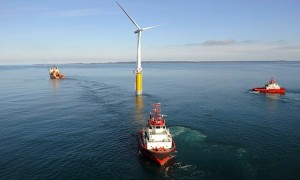Source: theguardian.com
Published: November 2, 2015

Construction on the UK’s first floating offshore windfarm is to begin in 2016. Photograph: Øyvind Hagen / Statoil ASA
Hywind Scotland project will see deployment of five floating turbines off coast of Peterhead, capable of powering 20,000 homes, reports edie.net
Matt Mace for edie.net, part of the Guardian Environment Network
The Scottish government has granted consent for the world’s largest floating offshore windfarm to be developed off the coast of Peterhead.
Oil and gas giant Statoil will build a 30MW pilot park consisting of five floating 6MW turbines, which could power nearly 20,000 homes. The project will be the UK’s first ever floating windfarm development, with construction set to start next year.
Statoil’s executive vice president for new energy solutions, Irene Rummelhoff, said: “Floating wind represents a new, significant and increasingly competitive renewable energy source. Statoil’s objective with developing this pilot park is to demonstrate a commercial, utility-scale floating wind solution, to further increase the global market potential.
“We are proud to develop this unique project in Scotland, in a region that has optimal wind conditions, a strong supply chain within oil and gas and supportive public policies.”
The development, known as Hywind Scotland, differs from conventional offshore windfarms by using turbines attached to the seabed by a three-point mooring spread and anchoring system. The turbines are interconnected by cables, one of which exports electricity from the pilot farm to the shore at Peterhead.
Research from the Carbon Trust has suggest that floating wind concepts could potentially reduce generating costs for offshore developments to below £100MWh, with larger concepts such as Hywind producing even lower costs of £85-95MWh. Currently the global average levelised cost of electricity for offshore projects is £112MWh.
Deputy first minister, John Swinney, said: “Hywind is a hugely exciting project – in terms of electricity generation and technology innovation – and it’s a real testament to our energy sector expertise and skilled workforce that Statoil chose Scotland for the world’s largest floating windfarm.
“The momentum is building around the potential for floating offshore wind technology to unlock deeper water sites. The ability to leverage existing infrastructure and supply chain capabilities from the offshore oil and gas industry create the ideal conditions to position Scotland as a world leader in floating wind technology.”
Last month the Energy Technologies Institute (ETI) released a report indicating that floating offshore wind could be a credible, cost-effective form of low-carbon energy for the UK by the mid-2020’s.
Swedish floating wind developer Hexicon also threw its support behind the cost competitiveness of floating offshore developments.
Hexicon’s international business development director Maurice Jenkens told edie.net: “It’s still a new technology and still needs massive investment to reach this tipping point, but inevitably that’s going to happen. It’s going to take 10 years of massive investment but time is the only real obstacle.”
